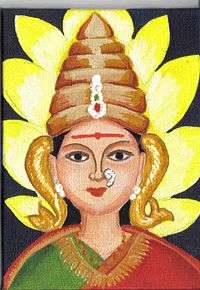Saibini
Saibini is the appellation for the Mother Goddess in Goa, India. It is also used by the Konkani people all along the west coast of India. The word can be translated as 'Dame' in the English titular sense.

Prior to the 1500s, the word was only used for the Goddess Shantadurga or Santeri. The beginnings of Goddess worship predates the coming of the Aryans in Goa and when the Saraswat Brahmins settled in Goa they adopted the tradition of worshipping the Mother Goddess by incorporating the Shakti tradition. The original tradition of worshipping the Earth Goddess Santeri at the site of ant hills continued along with the Aryan traditions of building temples. Thus the Goddess Shantadurga and Santeri were worshipped by all the sections of the Konkani people.
The Goddess Mhalsa of Mardol is also commonly referred to Saibini. The term is common amongst all the Konkani goddesses, including the ones found along the coastal belt of Karnataka.
The arrival of the Portuguese in Goa during the early sixteenth century and the en masse proselytization of the locals to Roman Catholicism in the Old Conquests of Bardes, Ilhas, and Salcette, resulted in the destruction of the temples of Santeri. The deep rooted traditions of woshipping the mother Goddess continued in her Catholic counterpart of Mother Mary. Thus, Mother Mary was called Saibini.
Our Lady of Miracles at Mapusa is called Milagres Saibini by Goan Catholics today. As Hindus and Catholics commonly worship together in many Goan churches, and temples, sometimes the distinction between Santeri and Mother Mary are lost.
The word is also commonly used for Mother Mary by the East Indian Catholics, a Marathi-speaking community. Mother Mary is also referred to as Saibini by the Konkani-speaking Catholics of Kanara.
All of Goan female deities are addressed as Saibinis. Even the Catholics, Mary is an example of motherhood and compassion and is referred to Saibini. Predominantly, the word is associated with Mother Mary and the Konkani Goddesses.
References
- Dr. Manohar Rai Sardesai (2000) "A History of Konkani Literature: From 1500 to 1992." Sahitya Akademi. ISBN 9788172016647.
- Marian hymns #Fatima Saibini. East-Indians.com. Retrieved on 25 July 2019.
- Honnavar: Konkani hymn CD 'Naman Ballok Jezu, Fatima Saibini’ released. 23 June 2018. Mangalore: Daijiworld Media Pvt Ltd. Retrieved on 25 July 2019.
- Maria Aurora Couto (2005) "Goa: A Daughter's Story." Penguin UK. ISBN 9789351180951.